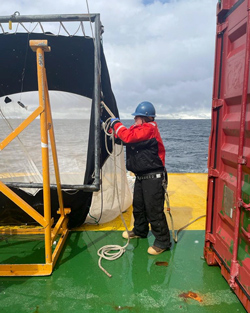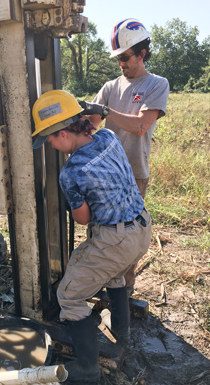Editor’s note: To help celebrate April as Undergraduate Research Month at William & Mary, we highlight here the growing synergy between W&M undergrads and faculty in the graduate School of Marine Science at VIMS.
Although traditionally focused on graduate studies, William & Mary’s School of Marine Science at the Virginia Institute of Marine Science is welcoming a growing number of W&M undergraduates to its labs, boats and classrooms.

“We have the enviable combination of immensely bright, creative and talented undergraduates and a world-class marine science institute,” says Derek Aday, VIMS dean & director. “It’s a huge opportunity for synergy that we continue to facilitate and encourage.”
Aday notes that the benefits of graduate-undergraduate collaboration run both ways. “Research offers students an important opportunity to expand their knowledge and skills,” he says. “It also provides our faculty with the opportunity to increase the reach and impact of their work through additional training opportunities and the fresh insights that students often provide.”
Linda Schaffner, associate dean of academic studies at VIMS, says “Research at VIMS provides William and Mary students with a deep and meaningful opportunity to engage in science. Undergraduate research is such an important part of a comprehensive education that we hope to increase opportunities as our academic program continues to grow.”
A key conduit for undergraduate involvement in VIMS research is W&M’s marine science minor. Launched in 2010, the program provides opportunities for undergrads to learn about openings in VIMS research programs directly from faculty, and gives faculty first-hand knowledge of student interests and capabilities.
VIMS Associate Professor Chris Hein co-directs the undergraduate marine science program with Jon Allen, associate professor of biology at W&M. He currently has seven W&M undergrads involved in his research program, which focuses on how barrier islands and other coastal systems respond to impacts from climate change.

Hein joins Aday in touting the two-way benefits of the undergraduate research connection. He says W&M undergrads benefit VIMS by “bringing new perspectives and energy to the science and the labs in which they work.” In the best cases, he adds, “the students can become an integral part of a lab for several years, completing a publication-worthy senior or honors thesis.” Since 2017, he has tallied 23 peer-reviewed publications from VIMS with a W&M undergrad as a lead or co-author.
From the student perspective, Hein says “Conducting research as an undergrad allows a student to explore an interest in great detail, while delving into the real-world scientific process, in which there is no ‘right answer’ as you’d find in a class exercise.”
Hein stresses that student immersion in research is particularly beneficial at an institute like VIMS, whose advisory mission offers opportunities that often have applied and socially relevant components. “Undergrads may well have a chance to interface with stakeholders and the general public through our outreach and advisory service missions,” he says. “This gives them a window into a world of opportunities and careers beyond academia.”
Hein notes the students’ time at VIMS also provides opportunities to interact with graduate students and technical staff. VIMS grad students contribute to and benefit from this connection by interacting with undergrads in the lab and teaching undergraduate courses on main campus. Eleven graduate students have taken advantage of teaching opportunities during the past two academic years, with another five scheduled to do so during 2022-2023. Course topics have ranged from aquaculture to hurricane impacts, coastal acidification, wetland biogeochemistry and marine bioinspiration.
The student perspective
At least 20 W&M undergrads are currently involved in research projects at VIMS, with 8 faculty members reporting one or more undergrads working in their lab or on a field project. The benefits of these relationships are clearly valued by students as well as faculty.
Cameron Clarke ’22 is one of the W&M undergrads conducting research in Hein’s lab, nearing completion of a senior thesis on Pleistocene sea-level change in Virginia.
“I’ve thoroughly enjoyed my time doing research as an undergraduate at VIMS,” she says. “Working with a professor who advises both undergrads and graduates has been an incredible way to not only dive deeper into my research project, but connect with a wider group of students, expand my knowledge on various types of research and help on various other projects.”
Grace Weeks ’23 joined Hein’s Coastal Geology lab in 2021 following her participation in the field course at VIMS’ Eastern Shore Laboratory. She says, “The Lab has allowed me to gain valuable hands-on experience in geology research and opened my eyes to careers and academic options after graduation.” Weeks says the experience has also “introduced me to wonderful people with different backgrounds and interests in research who have now become my mentors, role models and friends.”

Far afield from coastal Virginia, Meredith Nolan ’22 continues a multi-year tradition of W&M undergrads joining VIMS Professor Deb Steinberg’s crew for their annual oceanographic cruise through the Southern Ocean as part of the NSF-funded Palmer Long-Term Ecological Research Program.
“Doing field research in Antarctica was the most incredible experience,” says Nolan. “Every day, we collected more data and added our piece to a 30-year time series. It was amazing to be a part of important research on our changing climate in such an untouched place. I learned so much, saw beautiful wildlife and had the best time!”
Other W&M undergrads are conducting research on topics as diverse as the interests of VIMS faculty. Caela Gilsinan ’23 is partnering with VIMS Associate Professor Andrew Scheld to explore the viability of developing a large-scale surf-clam hatchery to offset potential losses to the fishery due to emplacement of offshore wind turbines. Ethan Dewald ’22 and Alex Pomroy ’23 are working with postdoctoral research associate Vaskar Nepal and Professor Mary Fabrizio to study the effects of salinity on gill morphology in blue catfish, an invasive species in the Chesapeake Bay.
Christian Longo ’22 is collaborating with Professor Grace Chiu to assess the spatial performance of computer models developed to simulate the role aquatic vegetation plays in storing carbon removed from the atmosphere, while Kate Davis ’22 is working with Chiu to reduce statistical uncertainties in a software program created to help monitor large-scale soil erosion. Ryan Hansen ’23 and Margaret O’Connor ’24 have been working on various projects in the lab of Assistant Professor Emily Rivest, whose research currently focuses on how ocean acidification impacts oysters and other marine life.

